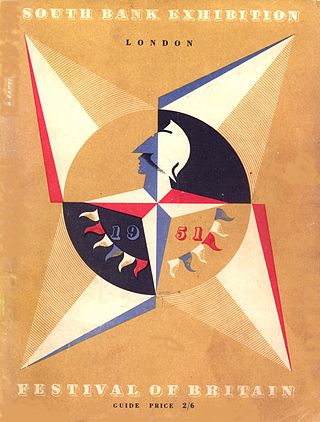National Rail (NR) is the trading name licensed for use by the Rail Delivery Group, an unincorporated association whose membership consists of the passenger train operating companies (TOCs) of England, Scotland, and Wales. The TOCs run the passenger services previously provided by the British Railways Board, from 1965 using the brand name British Rail. Northern Ireland, which is bordered by the Republic of Ireland, has a different system. National Rail services share a ticketing structure and inter-availability that generally do not extend to services which were not part of British Rail.

The Festival of Britain was a national exhibition and fair that reached millions of visitors throughout the United Kingdom in the summer of 1951.

A gender symbol is a pictogram or glyph used to represent sex and gender, for example in biology and medicine, in genealogy, or in the sociological fields of gender politics, LGBT subculture and identity politics.

Rail Alphabet is a neo-grotesque sans-serif typeface designed by Jock Kinneir and Margaret Calvert for signage on the British Rail network. First used at Liverpool Street station, it was then adopted by the Design Research Unit (DRU) as part of their comprehensive 1965 rebranding of the company.
Margaret Vivienne Calvert is a British typographer and graphic designer who, with colleague Jock Kinneir, designed many of the road signs used throughout the United Kingdom, Crown Dependencies, and British Overseas Territories, as well as the Transport font used on road signs, the Rail Alphabet font used on the British railway system, and an early version of the signs used in airports. The typeface developed by Kinneir and Calvert was further developed into New Transport and used for the single domain GOV.UK website in the United Kingdom.

Misha Black was a British-Azerbaijani architect and designer. In 1933 he founded with associates in London the organisation that became the Artists' International Association. In 1943, with Milner Gray and Herbert Read, Black founded Design Research Unit, a London-based Architectural, Graphic Design and Interior Design Company.
Herbert Spencer was a British designer, editor, writer, photographer and teacher. He was born in London.
Richard "Jock" Kinneir was a British typographer and graphic designer who, with his colleague Margaret Calvert, designed many of the road signs used throughout the United Kingdom, Crown Dependencies, and British overseas territories. Their system has become a model for modern road signage.
The Design and Industries Association is a United Kingdom charity whose object is to engage with all those who share a common interest in the contribution that design can make to the delivery of goods and services that are sustainable and enhance the quality of life for communities and the individual."

Motorway is a sans-serif typeface designed by Jock Kinneir and Margaret Calvert for use on the motorway network of the United Kingdom. Motorway was first used on the M6 Preston bypass in 1958 and has been in use on the UK's motorways ever since. The typeface is also used in some other countries, most notably Ireland and Portugal.
Milner Connorton Gray CBE (1899–1997) was one of the key figures of British industrial design in the 20th century, having played an important role in establishing design as a recognized profession, the emergence of British design consultancies, and the development of Design Management.

Britain Can Make It was an exhibition of industrial and product design held at the Victoria and Albert Museum in London in 1946. It was organised by the Council of Industrial Design, later to become the Design Council.
Sir Walter John Worboys, was an Australian-born British businessman and chemist. He is best known for widely reforming road traffic signage in the United Kingdom.

The British Rail Corporate Identity Manual is a corporate identity guide created in 1965 by British Rail. It was conceived in 1964, and finished in July 1965 by British Rail's Design Research Unit, and introduced British Rail's enduring double arrow logo, created by Gerald Barney and still in use today as the logo for National Rail. The manual spanned four volumes, and was created as part of a comprehensive redesign of British Rail following the Beeching Cuts as part of a plan to attract more passengers. It is noted as a piece of British design history.
Jacqueline Groag was an influential textile designer in Great Britain in the period following World War II. She produced and designed fabrics for leading Parisian fashion houses including Chanel, Lanvin, House of Worth, Schiaparelli and Paul Poiret.
John Robert Marcus Brumwell was a British advertising pioneer, designer, businessman, political activist, and art collector.

The British Rail Double Arrow is a logo that was created for British Rail (BR), the then state-owned operator of Britain's railway network, in 1965. It has remained in use as part of the National Rail brand used for Britain's passenger rail services after the disbanding of British Rail, having been officially renamed as the National Rail Double Arrow and more recently being updated and reworked for continued use under the name Rail Symbol 2.

Gerald Lawrence Barney is a British designer, best known for his 1965 British Rail Double Arrow, which is still in use in the UK.

Creek Vean is the Grade II* listed residential property in the village of Feock in Cornwall, England. It was the first building designed by Team 4, being commissioned by Su Brumwell's parents, Marcus Brumwell and Irene Brumwell. Construction began in 1963 and it was completed in 1966.











